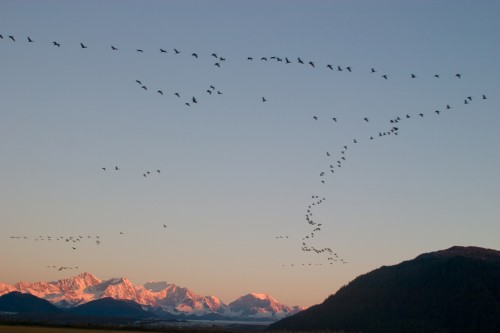The call of the sandhill crane

By Hank Leftner — Join us at the Learning Center on October 22-23, 2011 for a Sourdough Speaker Series presentation by Hank as he introduces us to his acclaimed new memoir Faith of Cranes: Finding Hope and Family in Alaska. Details at www.ncascades.org/speakerseries of by calling (360) 854-2599.
Beneath moon or sun, storm or calm, in every moment of every day for over ten million years the voice of a sandhill crane has called out somewhere on the planet in a seamless lineage of sound. There is cohesion in the chaotic calls of cranes; an invisible thread binding living beads, stitching the flocks, tying each generation to the next.
Cranes talk to their egg-bound chicks with murmurs and clicks. The chicks imprint on the sound; they yearn to follow that voice even before breaking free of the shell. The birds grow, add their high peeps to the throaty calls of the larger flock and are soon clucking to their own offspring. Our lives too are embedded in a rich sea of sounds. While still in the womb a fetus listens and responds to the muted tones of the world it will soon enter.
The rich diversity of sound, music and wind, laughter and bird song, sobs and sea surf, poems and snow fall, stories and crane calls, – guides us through our lives and hold us in place as surely as gravity keeps our feet pinned to the spinning earth. In the absence of sound and story prisoners, locked in solitary confinement, lose all orientation and quickly tumble toward insanity. The lineage of voices that hold us in place come from near and far, the furred and feathered, the newly born and the long dead.
The Greek word for a crane chorus is “inangling.” The Koyukun people of Alaska call sandhills “Dildoola” in mimicry of their call. Aldo Leopold described the sounds of approaching sandhills as the “tinkling of little bells, the baying of some sweet-throated hound, and a pandemonium of trumpets, rattles, croaks, and cries.” The ornithologist Scott Weidensaul describes the sound of a far off flock as “fingernails drawn along the teeth of several combs, but with a rich melodic sound, like delicate bamboo chimes struck with small mallets.” My friend Jen says it’s the ghost of an owl playing a wooden flute.
Sandhills are the loudest bird in the world. The resonance and volume comes through a trachea that doubles back on itself in a tightly curved S shape fused to the chest bone. Stretched out, the wind pipe is longer than the bird itself. Bony rings in this elongated tube make the whole apparatus vibrate during vocalization, amplifying and adding complex harmonics. The sound carries for miles. On still days I have heard the faint whisper of far-off cranes winging through a blue sky beyond the edge of sight. At tree top level, the sound of kettling cranes crescendos through the ears and reverberates against the chest.
I too am at a loss to pin the depth of sound onto the flat page. To me the fall chorus is the sound of an irresistible smile, the corners of my mouth and threads of cranes pulled by a common force. Not until I heard the thrumming of my child’s heart from somewhere in the dark of my wife’s belly did I feel a smile tugged into existence in quite the same way.


The use of words to describe the sandhill cranes are most melodius. I can almost hear them. Thank you for this article!